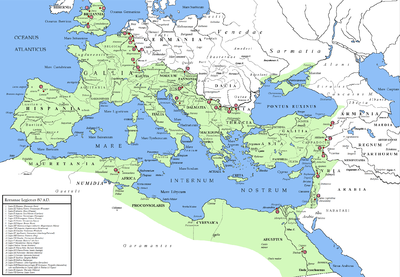A canaba (plural canabae) was the Latin term for a hut or hovel and was later (from the time of Hadrian) used typically to mean a town that emerged as a civilian settlement (canabae legionis) in the vicinity of a Roman legionary fortress (castrum).

A settlement that grew up outside a smaller Roman fort was called a vicus (village, plural vici). Canabae were also often divided into vici.
Permanent forts attracted military dependants and civilian contractors who serviced the base and needed housing; traders, artisans, sellers of food and drink, prostitutes, and also unofficial wives of soldiers and their children and hence most forts had vici or canabae. Many of these communities became towns through synoecism with other communities, some in use today.
Main article: List of Roman legionsSome Canabae of Legionary Fortresses:
- Canabae of Deva Victrix, later Chester, England
- Canabae of Isca Silurium, later Caerleon, Wales
- Canabae of Novae, Bulgaria
- Canabae of Vindobona, later Vienna
- Canabae of Argentoratum, later Strasbourg
- Canabae of Nijmegen, Netherlands
- Canabae of Troesmis, Romania
References
- "Brill's New Pauly Online". referenceworks. Retrieved 2024-11-28.
- Mason, D. J. P. (1987). "Chester: The Canabae Legionis". Britannia. 18: 143–168. doi:10.2307/526442. ISSN 0068-113X.
- THE NIJMEGEN Canabae Legionis (71-102/105 AD), MILITARY AND CIVILIAN LIFE ON THE FRONTIER, PAUL FRANZEN, Limes XX, Int. Congress on Roman Frontier Studies, Leon 2006.
- "Home". legionaryfortresses.info.
- C.-G. Alexandrescu (Hrsg.), https://www.researchgate.net/publication/311901643_The_Troesmis-Project_2011-2015_-_Research_Questions_and_Methodology_in_C-G_Alexandrescu_Hrsg_Troesmis_-_a_changing_landscape_Romans_and_the_Others_in_the_Lower_Danube_Region_in_the_First_Century_BC_-_